NGC Ancients: Coins of the Achaemenid Empire
Posted on 5/16/2023
By
Ben Wallace
NGC Ancients Grader
In an earlier column we discussed the gold and silver coins of the Kings of Lydia and the early coins of the Achaemenid Empire. In this article we’ll pick it up from there, taking a deeper dive into the coinage of the Achaemenid Empire.
The Achaemenid Empire (also called the Persian Empire) was immense, at its peak ruling lands from Greece to the border of India. The Persians fought and conquered some of the greatest nations of their era, with their government enduring for hundreds of years.
 |
A classic example of Persian coinage, a silver siglos of the 5th Century B.C., is shown above. It features the most common design elements of the empire's coinage: The obverse shows a crowned Persian hero or king running while holding a spear, and a bow and the reverse has a simple rectangular incuse punch.
Money played a key role in the success of this empire. The Achaemenid kings were among the first to make vast coinages of gold and silver. They had a regulated tax system, which allowed them to finance the administration and defense of their territory.
However, while these taxes allowed the empire to expand, it also helped lead to its downfall. The tax burden on the citizens grew with the continued expansion of the empire, leading to disgruntled citizens. The king's power was also weakened from assassination attempts and infighting at the highest levels of government.
Eventually, the Macedonian king Alexander III ‘the Great’ (356 to 323 B.C.) saw the diminishing fortunes of the empire and invaded. He was able to conquer almost the entire Persian Empire, adopting some of their governing and fiscal practices.
Now, we’ll review some of the interesting coin types of the Achaemenid Empire.
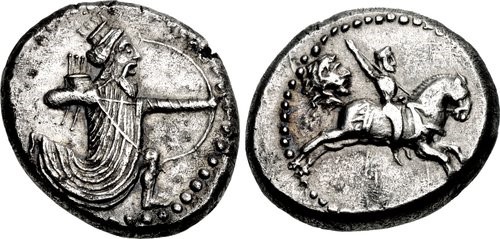 |
The obverse of this silver tetradrachm of c.400 to 341 B.C. shows the hero-king advancing, ready to discharge an arrow. The reverse has a charging horseman preparing to thrust a spear at an enemy; behind the rider is the head of the Greek hero Heracles wearing a lion skin headdress.
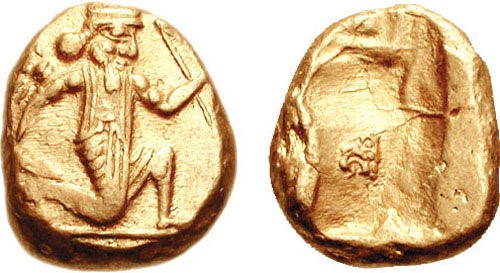 |
This gold daric of the 5th Century B.C. has a most uncommon feature. While the obverse shows the usual hero-king running with a bow and dagger, the reverse has a small lion's head in relief inside the incuse punch. The reason for this addition is unknown.
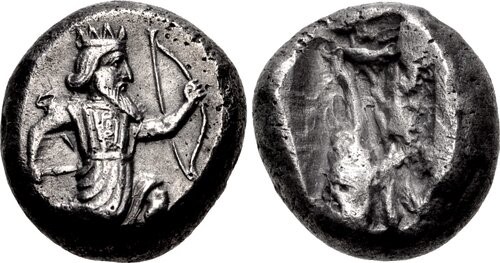 |
The above silver siglos of the 5th to 4th centuries B.C. shows the hero-king running while holding a bow and a dagger. This example is quite detailed in the face and clothing. The reverse has a rectangular incuse punch.
 |
It was unusual for bronze coins to be struck in the Achaemenid Empire. This 13mm bronze is an exceptional issue. Made c.350 to 333 B.C., the obverse shows the Persian hero-king running while holding a bow and a spear. The reverse shows an enigmatic design with two squares and a line projecting outward.
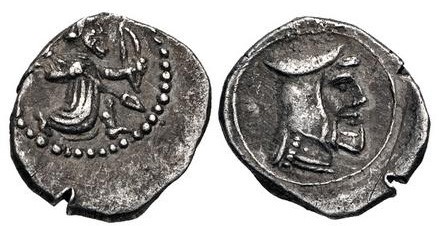 |
This tiny silver obol was made sometime during the 4th Century B.C. The obverse shows the hero-king running, while the reverse has the head of a Persian satrap wearing a bashlyk, a traditional headdress.
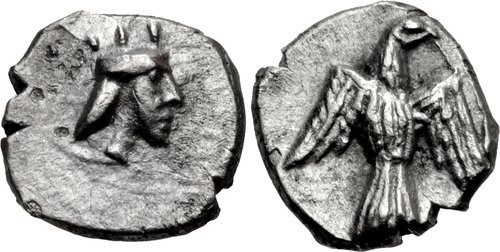 |
One of the lands conquered by the Persians was Judaea. It was under the Persians that some of the earliest coins of the Holy Land were issued, such as the silver half-gerah above. Made c.375 to 332 B.C., the obverse shows a bearded head, perhaps of the Achaemenid king, wearing a crown. The reverse shows a falcon in flight.
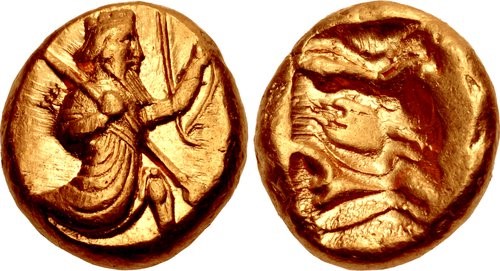 |
Nearing the end of the Achaemenid Empire, we get some evolution in style and composition, such as we see on this gold daric, made c.400 to 336 B.C. The obverse shows the hero-king in his traditional pose, holding a spear and bow. The reverse punch has a patterned design that gives the impression of waves or ripples.
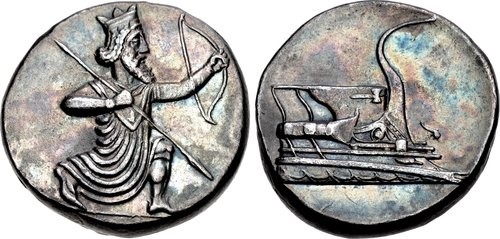 |
The above silver tetradrachm is amazing in every detail. Minted c.350 to 333 B.C., the obverse shows a well-rendered image of the hero-king holding a bow and spear. The reverse has the prow of a war galley decorated with a fearsome ram.
 |
We’ll finish our review of royal Persian coinage with this silver tetradrachm also minted c.350 to 333 B.C. It was struck at an unknown mint in Ionia (in western modern-day Turkey) near the end of the Achaemenid Empire. The obverse shows the hero-king running while holding a spear and bow, surrounded by the name of a Greek magistrate, “Pythagores.” The reverse features a most intriguing design, which may be a relief map of the hinterland of Ephesus — a city in Ionia where this coin may have been struck. Some of the shapes match up against the mountains and valleys in that area, making this perhaps the earliest Greek map and the first known physical relief map.
Images courtesy of Classical Numismatic Group.
Interested in reading more articles on Ancient coins? Click here.
Stay Informed
Want news like this delivered to your inbox once a month? Subscribe to the free NGC eNewsletter today!